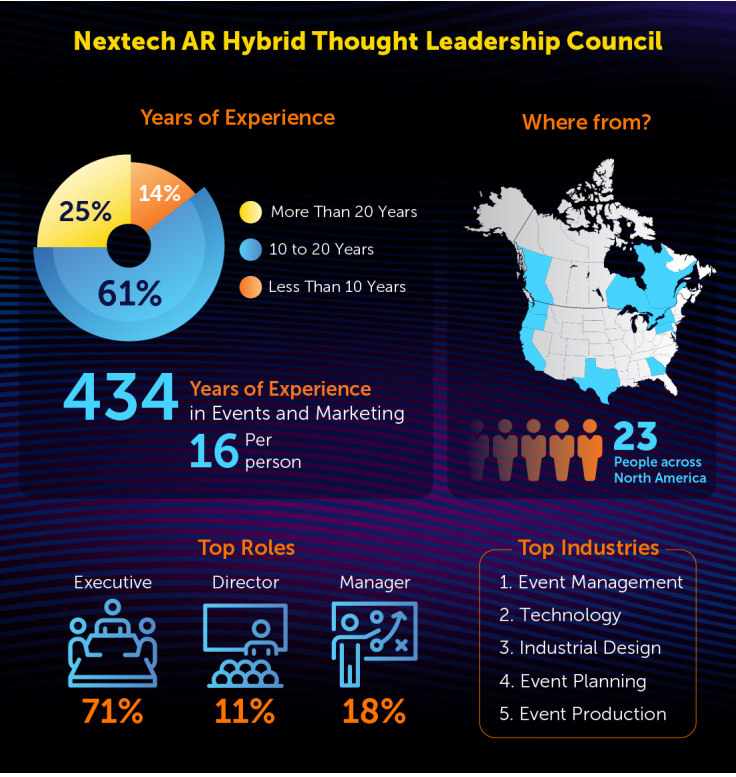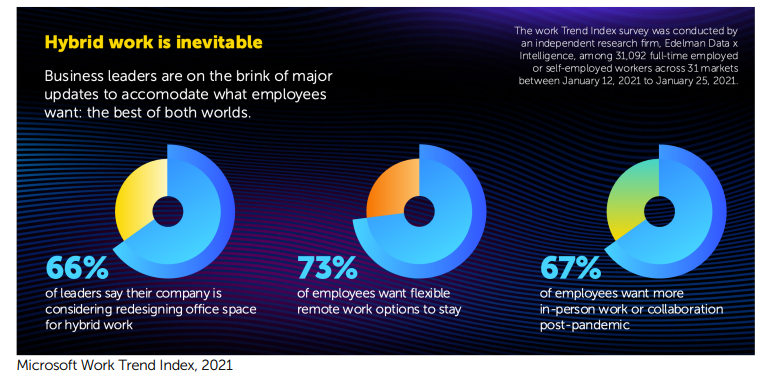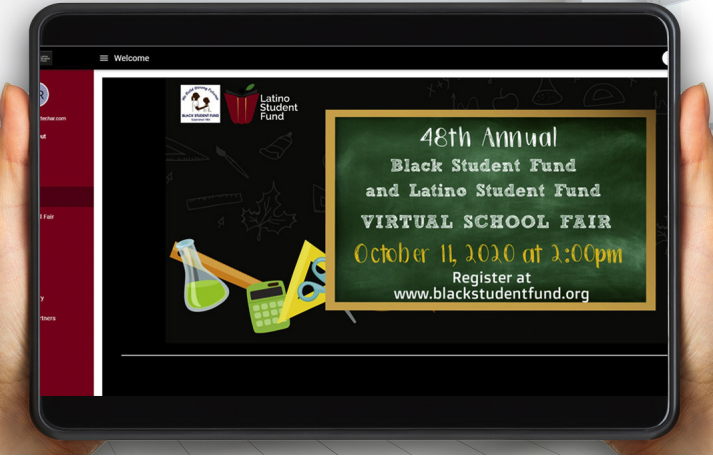Introduction
Virtual or hybrid events are not a new concept, though prior to 2020 it was an option, not a requirement. COVID-19 forced organizations to incorporate a digital strategy. What 2020 has taught us is that profound change can come out of nowhere, requiring your organization to have a contingency plan.
A 2014 survey of event planners indicated that 50% of them had never planned or attended a virtual event. Fast forward to 2021 where the virtual event market is to reach $41.58B by 2027 and increasing internet penetration has created several opportunities for market growth, says Fortune Business Insights™. As an event coordinator, how do you provide a remote experience that connects with your audience – such as attending a job fair, an academic conference, moderating a live thought leadership panel to thousands of people or launching a new product – if the attendees aren’t leaving their home office?
The shift to a mixed hybrid model for events is here to stay, with 65% of visitors and 57% of exhibitors expecting that digital event technology will still have utility after the pandemic ends, creating a unique convergence of requirements for event planners: the need to provide a virtual experience to connect and unite communities for learning, celebrating, worshiping and overall engagement, coupled with the need to find a way to cover costs and finding new revenue and sponsorship income to ensure funding streams and budgets stay intact.
The Hybrid Thought Leadership Council's (HTLC) 23 MICE - Meetings, Incentives, Conferences & Exhibitions experts - united to discuss how to create an events roadmap that facilitates the human connection through innovation and a return on experience.
Nextech AR brought together 23 leading experts in events, design thinking, and a technology futurist and TED speaker for a summit on the future of events. Agreeing that the future for events would be a hybrid model, this panel of industry experts, led by the design consultancy formfuture, drilled down into what that experience would look like and mean for event participants.

As vaccines and boosters continue to roll out across the globe, we're seeing in-person events starting to emerge, but inconsistently and with some hesitation, and the consensus is that the hybrid model is here to stay and will be the new standard.
In this blog, you'll learn how the HTLC envisions an exciting events future through 3 trends that will drive user connections, bringing people, experiences and technology together, driving a strong ROE for embracing a hybrid model.
- Unconference: redefining what a conference is by creating a seamless virtual and physical experience that amplifies participant collaboration through real-time interaction and providing fluid content influenced by the audience.
- Journify: utilizing data to guide, connect, and curate through shared commonalities and interests.
- Humanize: the ability to understand that participants need an individual experience based on their learning styles to boost their virtual and in-person experience.
The HTLC see these as the key trends that will drive a strong return on engagement for moving over to a hybrid events model.
Imagine building a captive and highly engaged audience by creating an adventure approach to experiences: a hologram greeting beamed into your living room, voting for topics you’re interested in, then attending an in-personal event based on your preferences. It’s possible.
Anthony Vade, CED Director North America Event Design Collective GmbH
First: Unconference
Traditional conferences are crafted by strict schedules, speakers and often static presentations reflecting only the content that the vendor or sponsor wants you to hear or see. You sign up and they determine the takeaways for your participation, often without your input.
What if planners could create and provide relevant content in real-time, based on audience input and engagement?
According to a Microsoft Work Trend Index study, hybrid work is inevitable and the next great disruption in how we do business. How we communicate and connect with customers and each other, with trackable returns, will shape the new economy.
The hybrid meeting is the first step towards the return of in-person meetings.
As vaccinations progress and the economy starts to open up, a slow return to in-person activities will happen, though not fully. Almost three quarters of planners (71%) plan to continue to employ a digital strategy to maintain their virtual audience once they return to physical events.

Through the Unconference trend, event planners can redefine what a conference is by creating a custom, seamless digital experience through:
- Attendees becoming the panel of experts within virtual events
- Providing multi-way communication independent of location
- Extending a single event into non-linear formats and follow up personalized experiences
Hybrid and digital technology can drive engagement and feedback from participants using:
- Gamification: polls, surveys, games, feedback
- Sponsorship/loyalty programs
- Ongoing personalized conversations
Next: Journify
Metrics matter. Data from a hybrid experience offers new ways to interact and redefine the entire timeline of an event, plus the content that draws the audience in.
This is the era of data-driven marketing and event design. Data is the key in making better business decisions and removing the guess work. In a hybrid event, you can leverage data during key activities to provide a return on engagement such as:
- Creating pre-event kits that take registration information and their areas of interest to develop a pre and post personalized event experience
- Providing ‘match-make’ sessions with people and companies based on audience preferences and input over the course of the event
- Developing a targeted follow up per participant
From pre-registration to post-event activities, creating a personalized customer journey that is trackable and measurable extends the lifetime of your event and overall engagement.
Event planners need to be able to track the customer journey with their preferences, be able to analyze the digital experience and apply the overall insights into an actionable plan.
Relying on live tradeshow principles will not work in the virtual or hybrid world.
Fully embracing online activities such as advertising, sponsorships and polling – before, during and after an event, will heighten the customer experience.
Through the Journify concept, by mapping out the event and attendee journey, organizers and marketers are able to extend the lifetime of their messaging and assets. They can aggregate content and offer new perspectives to different audiences, creating new opportunities for revenue streams.
“Hybrid events enable you to redefine the entire timeline of an event. The event is no longer just the 3-5 days, there can be pre and post event dialogue with interactions that are meaningful and creative.”
Marie-France Watson, CED, DES Event Designer, Digital & Live Event Strategist, Concordia University
Always: Humanize
Hybrid experiences offer the unique ability to humanize and better connect with each attendee. Where once an event is created for the masses, the digital world enables planners to inject some personality, and even playfulness into their events.
The key to humanizing an event is understanding that everyone grasps and absorbs information differently and provide for their differences. The hybrid experience needs to market to the senses, allowing for various kinds of learners – visual, auditory or kinesthetic – in order to connect fully with your audience.
Visual: Learners whose motto might well be “seeing is believing.” They process information best when it focuses on visual assets, such as graphs, charts, and infographics. They are also good at processing copy if they can see it (as opposed to having it read to them). They’re good at processing detailed visual presentations.
Auditory: Learners, as the name suggests, like to hear information. They grasp concepts better through the back and forth of conversation and brainstorming sessions—and they’ll often parrot what someone else says, to reinforce concepts in their own thinking.
Kinesthetic: Have you ever tried to explain how to work a remote to someone who grabs it out of your hand and says, “give me that thing—I can figure it out for myself?” That person is a kinesthetic learner- someone who is most likely to understand a concept (or product or service) if they get to try it out for themselves.
Regardless of how individuals learn, your ability to humanize your hybrid events, effectively positioning each asset or message to right person at the right time with the desired outcome: monetizing the return on experience.
“With Hybrid experiences we can create more sensory experiences by using technology to enable you to touch, taste and smell.”
Herman Chan, Designer and Co-Founder, formfuture
Key Takeaways
As Zoom fatigue persists, event planners and organizers need to be ready and able with the tools to provide an alternative that is grounded in the notion of a personalized experience.
Best practices include:
- Investing in a solid, expandable hybrid events platform
- Knowing your audience and planning collaborative activities before, during and after the event with a strong digital content strategy to draw attendees and gain insights into their needs
- Utilizing the event learnings to launch a post-event campaign based on learnings, releasing the event content with a fee structure or call to action for access
Through the concepts of Unconference, Journify and Humanize, event planners will be able to facilitate personal connections, increase traffic and leads, boost the customer experience in a virtual world and create value by providing a positive overall return on experience.
About Nextech AR
At Nextech AR, we offer a comprehensive range of virtual experiences that empower you to reach internal, external and partner audiences across time zones and languages, in a virtual, hybrid or face-to-face environment. Nextech AR’s custom experiences are powered by studio-level broadcasting, stunning custom lobbies, general sessions, interactive workshops, expo halls, networking features and Augmented Reality. Our experience dashboard delivers compelling insights into key metrics and ROI.
Most Nextech AR customers choose to enhance their programs by including our industry-leading Augmented Reality with dazzling 3D models, human holograms and 360 portals to create a truly unforgettable branded event, learning portal or a product showroom.
Ready to expand your reach with a virtual event? Check out our platform fit with all the essentials and exciting Augmented Reality features here!







